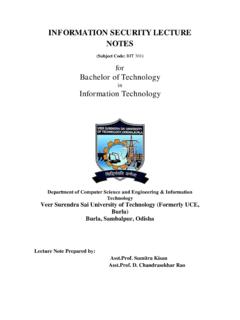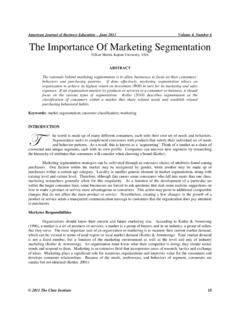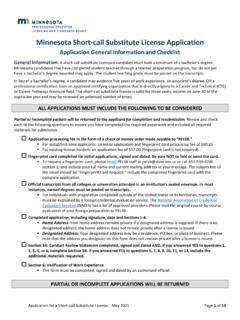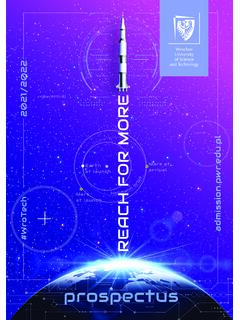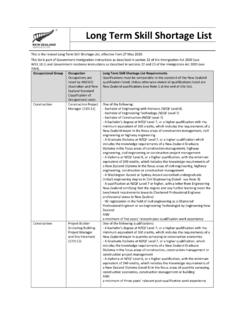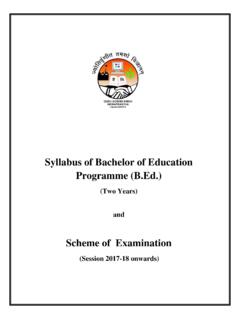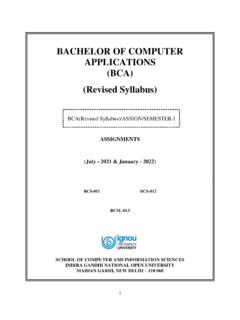Transcription of (Subject Code: BCS-404) for Bachelor of Technology
1 ARTIFICIAL INTELLIGENCE LECTURE NOTES (Subject Code: BCS-4 04) for Bachelor of Technology in Computer Science and Engineering & Information Technology Department of Computer Science and Engineering & Information Technology Veer Surendra Sai University of Technology (Formerly UCE, Burla) Burla, Sambalpur, Odisha Lecture Note Prepared by: Prof. Pradipta Kumar Das Prof. D. Chandrasekhar Rao Prof. Kishore Kumar Sahu DISCLAIMER This document does not claim any originality and cannot be used as a substitute for prescribed textbooks. The information presented here is merely a collection by the committee members for their respective teaching assignments.
2 Various sources as mentioned at the end of the document as well as freely available material from internet were consulted for preparing this document. The ownership of the information lies with the respective authors or institutions. BCS-404 ARTIFICIAL INTELLIGENCE (3-1- 0) Module - I Formalized symbolic logic: Propositional logic-first order predicate logic, wff conversion to clausal form, inference rules, the resolution principle, Dealing with inconsistencies and uncertainties, fuzzy logic. Module - II Probabilistic Reasoning Structured knowledge, graphs, frames and related structures, Knowledge organization and manipulation. Module III Matching Techniques, Knowledge organizations, Management.
3 Module - IV Natural Language processing, Pattern recognition, expert systems. Text Book: 1. Artificial Intelligence, Dan W Patterson, Prentice Hall of India (1999) Chapter-4, 5,7,9,10,11,12,13,15. Reference Books: 1. Artificial Intelligence, Nils , ELSEVIER. 2. and , Artificial Intelligence, - TMH Overview of Artificial Intelligence What is AI ? Artificial Intelligence (AI) is a branch of Science which deals with helping machines find solutions to complex problems in a more human-like fashion. This generally involves borrowing characteristics from human intelligence, and applying them as algorithms in a computer friendly way. A more or less flexible or efficient approach can be taken depending on the requirements established, which influences how artificial the intelligent behavior appears Artificial intelligence can be viewed from a variety of perspectives.
4 From the perspective of intelligence artificial intelligence is making machines "intelligent" -- acting as we would ex pect people to act. o The inability to distinguish computer responses from human responses is called the Turing test. o Intelligence requires knowledge o Expert problem solving - restricting domain to allow including significant relevant knowledge From a business perspective AI is a set of very powerful tools, and methodologies for using those tools to solve business problems. From a programming perspective, AI includes the study of symbolic programming, problem solving, and search. o Typically AI programs focus on symbols rather than numeric processing.
5 O Problem solving - achieve goals. o Search - seldom access a solution directly. Search may include a variety of techniques. o AI programming languages include: LISP, developed in the 1950s, is the early programming language strongly associated with AI. LISP is a functional programming language with procedural extensions. LISP (LISt Processor) was specifically designed for processing heterogeneous lists -- typically a list of symbols. Features of LISP are run- ti me type checking, higher order functions (functions that have other functions as parameters), automatic memory management (garbage collection) and an interactive environment. The second language strongly associated with AI is PROLOG.
6 PROLOG was developed in the 1970s. PROLOG is based on first order logic. PROLOG is declarative in nature and has facilities for explicitly limiting the search space. Object-oriented languages are a class of languages more recently used for AI programming. Important features of object-oriented languages include: concepts of objects and messages, objects bundle data and methods for manipulating the data, sender specifies what is to be done receiver decides how to do it, inheritance (object hierarchy where objects inherit the attributes of the more general class of objects). Examples of object-oriented languages are Smalltalk, Objective C, C++.
7 Object oriented extensions to LISP (CLOS - Common LISP Object System) and PROLOG (L&O - Logic & Objects) are also used. Artificial Intelligence is a new electronic machine that stores large amount of information and process it at very high speed The computer is interrogated by a human via a teletype It passes if the human cannot tell if there is a computer or human at the other end The ability to solve problems It is the science and engineering of making intelligent machines, especially intelligent computer programs. It is related to the similar task of using computers to understand human intelligence Importance of AI Game Playing You can buy machines that can play master level chess for a few hundred dollars.
8 There is some AI in them, but they play well against people mainly through brute force computation-- looking at hundreds of thousands of positions. To beat a world champion by brute force and known reliable heuristics requires being able to look at 200 million positions per second. Speech Recognition In the 1990s, computer speech recognition reached a practical level for limited purposes. Thus United Airlines has replaced its keyboard tree for flight information by a system using speech recognition of flight numbers and city names. It is quite convenient. On the other hand, while it is possible to instruct some computers using speech, most users have gone back to the keyboard and the mouse as still more convenient.
9 Understanding Natural Language Just getting a sequence of words into a computer is not enough. Parsing sentences is not enough either. The computer has to be provided with an understanding of the domain the text is about, and this is presently possible only for very limited domains. Computer Vision The world is composed of three-dimensional objects, but the inputs to the human eye and computers' TV cameras are two dimensional. Some useful programs can work solely in two dimensions, but full computer vision requires partial three-dimensional information that is not just a set of two-dimensional views. At present there are only limited ways of representing three-dimensional information directly, and they are not as good as what humans evidently use.
10 Expert Systems A ``knowledge engineer'' interviews experts in a certain domain and tries to embody their knowledge in a computer program for carrying out some task. How well this works depends on whether the intellectual mechanisms required for the task are within the present state of AI. When this turned out not to be so, there were many disappointing results. One of the first expert systems was MYCIN in 1974, which diagnosed bacterial infections of the blood and suggested treatments. It did better than medical students or practicing doctors, provided its limitations were observed. Namely, its ontology included bacteria, symptoms, and treatments and did not include patients, doctors, hospitals, death, recovery, and events occurring in time.

